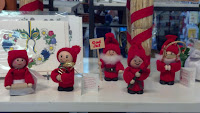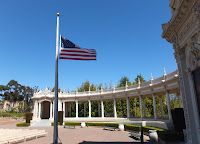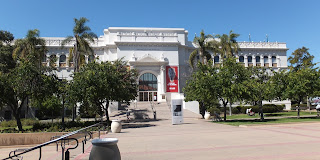St. Paul's Cathedral is close to Balboa Park so I decided to see what was happening there today. They were erecting kiosks for Earth Day on Sunday. The International Houses are only open on Sunday so I stopped into the gift shop, a deadly place for me, TeeHee. I found out because of Earth Day they won't be open this Sunday and it will be super crowded, so I am glad I came today.
 |
| One open out of 3, glad it's the Gift Shop. |
 |
| Many counties have a little house to share their culture. |
 |
| Scandinavian, of course. |
 |
| Close up of the Tomte', good elves. |
 |
| The Swedish Christmas Goat. Skylar and I always watch the Gavle goat in Sweden to see how long it will last. |
 |
| My family knows how much I love advent calendars and they will be surprised this didn't find it's way into my basket! |
 |
| African creche'. |
 |
| Another African one. |
 |
| From Peru |
 |
| Tiny, precious, holy families from Mexico |
 |
| Even the parking is pretty. |
 |
| Looking out. |
 |
| Looking across. |
 |
| I cropped the chairs, the stairs, and the hedge so you can see what can be seen from the stage, The Mall. |
 |
| Good memories of being with Skylar. |
 |
| This is the side view of the gardens leading up to the Mall. |
San Diego Natural History Museum, otherwise known as "The Nat"
 |
| I only had 2 hours before it closed. I'm sure you could spend much more time if you read everything! |
 |
| Thought it was an Ansel Adams exhibit, but NOT! Artists inspired by him. |
 |
| Loved this pendulum and watched it longer than I looked at the exhibits! I'm sure my James Uncle that tried to invent the perpetual motion machine would have loved it too! |
Because of air friction and gravity the pendulum would eventually stop swinging, but a magnet encircling the cable pulls on the cable with each swing. Electric current controlling the magnetism is turned on and off with each swing of the pendulum.
The Earth appears to be rolling like a barrel. As the pendulum swings, it does not move around the circle at all. Latitude determines the length of time required for a complete trip around the circle. Here in San Diego, the pendulum makes its way around the circle in 44½ hours!
 |
| Glad these things aren't roaming my neighborhood these days! |
 |
| Never know where you will find something! |
 |
| Camp-O-Saurus In the atrium is this delightful playroom for kids. |
 |
| Aaaawh |
 |
| "Jaws" |
 |
| Our beloved Manatee. |
 |
| Wonderful exhibits in natural habitat with lots of interaction. |
 |
| Ah, California has them, too! Or, used to have them! |
 |
| Interesting way to show us how we think maybe they looked. |
 |
| Easy to recognize this is a turtle, but one of long ago. |
 |
| "On the Trail of Ansel Adams" Many used the printing process called platinum printing. |
 |
| Lewis Abulafia "Yellowstone Winter #1" 2008 Archival Pigment on Cotton Rag 25 x 33 Framed |
 |
| John Ford "Denaili Summit" Alaska; 2011 Pigment Print 16 x 20 |
 |
| Water, A California Story |
 |
| Ah, my love for topographical maps. Now, let's see, Where have I been? and where am I going? Oh, I'm supposed to be looking for water. LOL |
 |
| Some of California water comes as far away as the Hoover Dam |
 |
| Over the hill isn't cheap. |
 |
| Shows the baleen, how whales eat. |
 |
| Gray Whale |
 |
| A chuckle in the gift shop. |
 |
| These were in a wonderful exhibit that moved, made noises and the colors changed. I was expecting to smell swamp odors any minute! It made the scene very real. |
 |
| BARYONYX (bah-ree-ON-icks) Wonderful exhibit. Not only did the head and paw move up and down, the fish swam around and around. Funny, the fish never got caught! LOL |
 |
| Close-up |
 |
| They had three sized chairs to show perspective. |
 |
| Where to start first? It's so much to see. plus all the rooms on the sides. |
 |
| Love biology and the anatomy of cells From what we see, smaller, and smaller, and smaller. So interesting. |
 |
| From the body to a single hair. |
 |
| Parts of the cell. |
 |
| 3-D show it well. |
 |
| A display on stem cells. Explains what exactly is a stem cell and why they are important in today's search for repair of our cells. |
 |
| More information by screen. |
 |
| Thought about Skylar again. |
 |
| Here was an interesting experiment. |
"Flight of the Butterflies" told about the 40 year search by Dr. Fred Urquhart in Toronto, Canada which lead to finding where the monarchs winter in Mexico in 1975. Dr. Urquhart tagged butterflies and asked for help all over the USA to chart the migration pattern. Thousands helped by sending their location to him. It's a heart rending story when Dr. Urquhart travels to Mexico in his old age and finds a butterfly with his label.
 |
| Two Monarchs. The chart shows California migrations go to several places in the mountains. |
 |
| From the Science Museum website. |

No comments:
Post a Comment